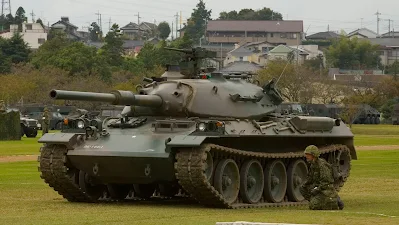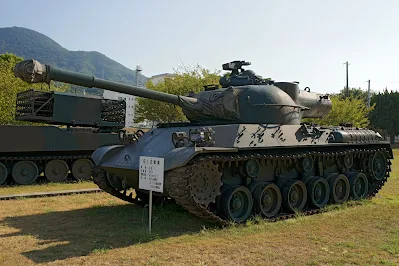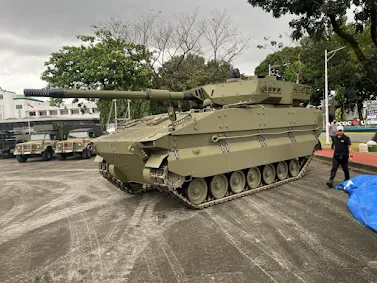Previously, Japan has provided the Philippine military a handful of air search radars from its own budgetary requirements, enabling the former to have the first of its defense and military export of its kind since the relaxation of laws that restrict the country from such arrangement.
The bilateral relations between both countries, especially regarding to national defense, have come more vibrant lately that the Philippine Army may get the likelihood of getting more armored vehicles, especially the one that is about to discuss in this article.
FROM THE REPORTS
 |
| Providing the Philippine Army with Type 74 tanks from JGSDF stocks may help boost its armor a bit. Image Source. |
Previously, discussions on Japanese military hardware possibly getting provided to the Philippine military came along, with the Philippine Army being the primary recipient of these assets, in an event that these plans push through. Typically, the discussions previously discussed on this website usually talk about the air assets that the Japan Ground Self-Defense Force may provide this service branch with, such as the UH-1J Combat Utility Helicopters and the AH-1S Cobra Attack Helicopters.
However, the aforementioned military hardware coming from stocks within the Japan Ground Self-Defense Force inventory isn't the only one that may likely end up in the hands of the Philippine Army, as there is a single type of armored vehicle that the Japanese shows some willingness to provide their Philippine counterparts that may boost its armored capabilities aside from the ones it already have like the Sabrah Tanks (of both ASCOD 2 and Pandur II chassis) coming from Israel's Elbit Systems Ltd.
The said armored vehicle refers to the Japanese-made Type 74 tank (see image above), as these platforms are something that the Philippine Army officials are interested to get on, as these main battle tanks, along with their UH-1J Combat Utility Helicopters, are on the process of getting a schedule for its eventual decommissioning out of active service from the Japanese military.
Japan's plans for decommissioning both its Type 74 tank and UH-1J Combat Utility Helicopters also coincide with their military's plans to decommission their AH-1S Cobra Attack Helicopters, as their security defense policy update sees these platforms obsolete and now in the process of getting replaced by unmanned aerial systems or drones that they may see as more relevant to their defense-related requirements. On the other note, the decommissioning of UH-1J Helicopters comes as the Japan Ground Self-Defense Force gets newer helicopters like the UH-2 Combat Utility Helicopter, itself a Bell 412 variant that the Philippine Air Force also have and has plans to add more later on (See page 84 of the SARO release list PDF File).
While some media outlets are quick to brand this information as 'fake', this information holds plausibility as the Philippine Army's idea of getting Type 74 Tanks has gotten rounds on several defense outlets that come with credibility even before the mainstream media gets it, along with the information that Pitz Defense Analysis have that gives full verification for this military asset from Japan.
Hence, the Type 74 Tanks deserves a discussion of its own for the sake of obtaining it, as the possibility for the Philippine Army of getting it is there, although it is not necessarily 100% guaranteed as plans changes from time to time and there are several cases that the end-user decided not to pursue the project itself, such in this case regarding both the Philippine Army and Marine Corps' Multiple-Launched Rocket System acquisition project, presumably what would be the K-136 Kooryong MLRS from South Korea.
In this topic, we will discuss its development, specifications, and an elaborate comparison with the other tanks that Japan Ground Self-Defense Force has, as the plans of decommissioning the tanks came as the Japanese are on the process of introducing its newest Type 10 Main Battle Tanks into service, as it really comes as a replacement to the older tanks like the Type 74.
TANK'S DEVELOPMENT
 |
| The Type 61 tank has served as Japan’s first Indigenously made tank since the end of the Second World War. Via Wikimedia Commons. |
Through the years, the fleet of armored vehicles like tanks within the Japan Ground Self-Defense Force or JGSDF constantly changes and improves in a manner that a new type of tank gets introduced in the Japanese military service, effectively replacing older ones in inventory that they may render as obsolete. This is actually what is happening with Type 10 Tanks slowly replacing the older Type 74 Tanks that have the possibility of getting its way to the Philippine Army’s inventory shall things push through.
This was also the case for the Type 74 Tanks when it was first developed in the early 1970s, whereby the Japan Ground Self Defense Force, in partnership with Mitsubishi Heavy Industries, is looking for a new Tank that intends to replace the Type 61 Tank. The said tank was the first indigenously made Japanese tank in the early years of the Cold War and also the one made since the conclusion of the Second World War and the formation of Japan’s pacifist constitution that made the Japan Ground Self Defense Force today.
With the development of the Type 61 Tank took place in the mid-1950s by Mitsubishi Heavy Industries, the renewed experience in creating the design and having the tank mass-produced help the company and Japan Ground Self-Defense Force in developing far advanced tanks and armored vehicles along the way, enabling them to conceptualize and getting the works started in the early 1960s as a counter to the Soviet-made T-62 series that Japanese says that is out of scope for their existing aforementioned tank.
Once the work has started, Mitsubishi Heavy Industries produced different prototypes and started testing different design features and tank hulls such as the STB-1 prototype featuring an adjustable hydro-pneumatic suspension system of the discontinued American/German MBT-70 tank, while using a German Leopard 1 tank as its basic hull tank design and its main gun being a British 105mm L7 rifled main gun tied to an automatic loader developed and produced by Japan Steel Works Company. While the development is promising, its limitations forced the parties involved to make some necessary revisions in their design.
The revisions in the design became what they named as the STB-3 tank prototype, whereby the development pushed further in the early 1970s until they reached the STB-6, a final test prototype of the tank prior to its acceptance and compliance to the Japan Ground Self-Defense Force and eventually, the mass production of this tank design. In 1974, the JGSDF formally accepted it and has provided the designation ‘Type 74’ tank, which connotes the year it entered service and since then, became the mainstay tank of the Japanese military for years to come.
Since its introduction to the Japan Ground Self-Defense Force, Mitsubishi Heavy Industries produced at least almost 900 units of the Type 74 Tank, spanning at least 10 versions of the tank produced in the 1980s. The production line for the tanks has since then shut down in 1989 to give way for the newer, more sophisticated Type 90 tanks for production, of which it serves as a complementary main battle tank to the Type 74, itself a Second Generation tank of the Japanese military of the post World War 2 era.
The Type 74 tank served as Japan’s mainstay tank during the remaining years of the Cold War era, whereby the design features and weapons components come as applicable for the armored vehicles of that era. It is not surprising that the Japan Ground Self-Defense Force produced the modern Type 10 main battle tank as the 1970s-era Type 74 tank no longer suits their needs. As for the Philippine Army, having such tanks may provide a boost for its armor division, complementing the Sabrah Tanks it currently has in inventory.
SPECIFICATIONS
 |
| The detailed specifications are in the image provided. Image © Wikimedia Commons, with spec-sheet reference from Military-Today website. |
The specifications that the Type 74 Tank of the Japan Ground Self-Defense Force or JGSDF comes as a byproduct of continuous development resulted from the previous prototypes that Mitsubishi Heavy Industries has made, aiming to improve the prospect of a second-generation main battle tank designed to replace the Type 61 Tank, the first indigenously made main battle tank of Japan since its defeat in the Second World War and the adoption of having a defense-oriented armed forces, which it still has today.
According to the descriptions made by a spec-sheet oriented defense outlet about the Type 74, the tank provides an impression that the tank produced by Mitsubishi Heavy Industries for the Japan Ground Self-Defense Force that it entered service in 1975 as an already-obsolete tank, describing that other contemporary Western-made tank designs that entered service in the 1980s rendered the second generation Japanese-made tank as an out-of-date platform, in need of complementary and more capable platforms such as the Type 90 tank.
Delving into the details, the Type 74 tank’s dimensions come with a weight of 38 tons, length of 9.42 meters with gun forward, hull length of 6.7 meters, width of 3.18 meters, and height of 2.67 meters. In comparison, the Sabrah Light Tank - ASCOD 2 chassis of the Philippine Army comes with a weight of 30 tons, a length of 9.5 meters with gun forward, hull length of at least 7.6 meters (ASCOD 2), a width of 3.4 meters (ASCOD 2), and a height of 2.5-2.8 meters for the ASCOD 2 hull alone (with around 3.5-3.8 meters that includes the turret).
The dimensions make the Type 74 tank of Japan Ground Self-Defense Force coming almost to par with the Sabrah ASCOD 2 tank in terms of size, with the latter being as a larger type for a Light Tank as the chassis comes originally designed as an Infantry Fighting Vehicle for both Spain and Austria. Despite the size differences, both tanks have the same 105mm caliber main gun, with the Sabrah Tank manned by at least three (3) people as opposed to the Type 74 tank’s four (4) personnel. The Sabrah Tank’s reduced crew configuration became possible as it comes with an automatic loading system onboard.
The said Japanese tank’s engine comes with a single Mitsubishi 10ZF Model 21 10-cylinder diesel engine delivering 750 horsepower, an engine that is likely seen uniquely with the tank that it comes installed. In comparison, a Sabrah Tank with ASCOD 2 chassis comes with the 805 horsepower MTU V8 199 T21 diesel engine, making the latter more capable in terms of engine power that comes alongside with its weight that is lighter than what the Japanese Type 74 Tank comes with its design.
The power produced by the Mitsubishi-made engine enabled the Type 74 tank of the Japan Ground Self-Defense Force to travel at a maximum speed of 53 kilometers per hour, at a range of 400 kilometers. The ASCOD 2-based chassis of the Sabrah Light Tank comes faster at its maximum speed of around 70 kilometers per hour, with its range of around 500 kilometers. This is not surprising as the ASCOD’s design comes with a requirement fit for an Infantry Fighting Vehicle or IFV.
Despite the difference, of which coming with a thick armor of 80mm on the upper body part of the tank and has a defensive ability of 195mm, the Type 74 that the Japan Ground Self Defense Force plans to decommission are a worthy consideration for the Philippine Army leadership to check, even though it remains to see whether getting this type of tank will push through, or not at all.
TO SUM IT UP
 |
| The Philippine Army aims to augment its Sabrah tanks in terms of numbers. Image Source. |
The Philippine Army aspires to get additional Medium Main Battle Tanks or a fleet of Light Tank units for its operations, as the Sabrah tank orders of both the ASCOD 2 and Pandur 2 6X6 chassis under its current contract does not suffice the numbers as we get the additional information discussed in the final part of this article, shortened for straightforward discussion under this topic.
Adding here are some sufficiently gathered relevant and fairly important types of information that provide insight about the Philippine Army’s acquisition plans relating to the Medium Main Battle Tank (MMBT) units for the Armor “Pambato” Division to use. The abbreviation and description provided come as the current designation of the service branch for a Light Tank, such as Elbit’s Sabrah Light Tank of both ASCOD 2 and Pandur 2 8x8 chassis.
One point of information here is the Philippine Army’s idea of getting and maintaining at least 144 units of Medium Main Battle Tanks or MMBTs, whereby the numbers provided are insufficient if we refer to the number of Sabrah Tanks ordered by the Philippine Army at its current contract arrangement of 28 units. The idea of filling it up comes when the idea of getting Type 74 tanks from JGSDF stocks gets into consideration. It shows that the numbers are still a requirement for the Philippine Army to have as part of its operational needs.
The idea of getting Japan’s Type 74 Tanks come as its eventual retirement from service becomes more inevitable with the entry of Type 10 Main Battle Tanks within the active service of Japan’s own Ground Self Defense Force units, coming along other potential offers that the said country has in offering to the Philippine Armed Forces, ranging from its locally produced UH-1J Huey Helicopters to the AH-1S Cobra Attack Helicopter that are potentially up for grabs, possibly benefiting the Army’s Aviation ‘Hiraya’ Regiment.
In summary, getting the Type 74 Tanks came as an interesting proposition that may help improve the capabilities of the Philippine Army’s armored vehicle capabilities, especially regarding into the idea of fielding the number of Medium Main Battle Tanks that augments the current number of Sabrah Tanks of both wheeled and tracked variants ordered from Israel’s Elbit Systems Ltd. While being idealistic, this concept remains as simply a plan, unless there is a clear emphasis that this prospect actually turns into reality.









.png)



No comments:
Post a Comment